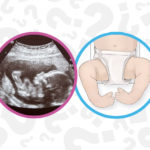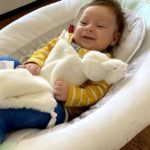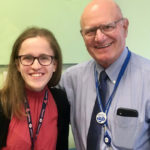One family, two very different clubfoot experiences
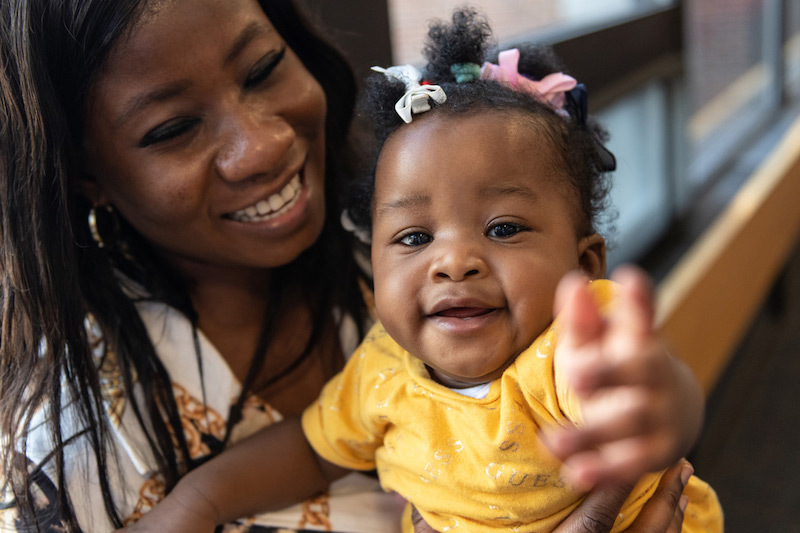
Theresah Boateng and her daughter Eno Agyapomaa Agyemang both have strong wills and outgoing personalities. Both were born with a foot deformity called clubfoot, and both received treatment at Boston Children’s Hospital.
Yet their experiences differ in many ways. Theresah’s treatment started when she was 15 years old and lasted more than two years. Eno’s started when she was 2 weeks old and took less than three months. Their story is one of family, resilience, and innovations in clubfoot treatment.
A childhood without clubfoot treatment
Theresah was born in Ghana with severe clubfoot in both feet. Instead of facing the ground, the soles of her feet turned inward and up. For years, she walked on the sides of her feet, including one mile to school and one mile back. Some afternoons she would play soccer with her friends, but often the pain and effort of simply walking drained her energy.
“My family didn’t have money to take care of my feet when I was little,” recalls Theresah. “By the time we tried to fix it, the doctors said it was too late.”
Theresah’s older sister Gifty believed those doctors were wrong. Gifty was raising her family in Massachusetts and showed a picture of Theresah’s feet to her children’s pediatrician, Dr. Alena Ashenberg. Their conversation set off a string of events that changed Theresah’s life.
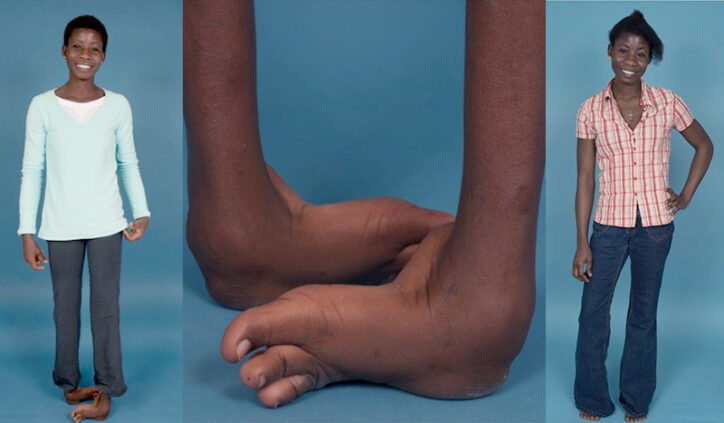
Dr. Ashenberg (now a part of Boston Children’s Primary Care Alliance) set out to find someone to correct Theresah’s feet. She contacted a number of specialists, most of whom told her Theresah’s clubfoot was too severe and her bones too mature for treatment. But Dr. James Kasser of Boston Children’s Orthopedic Center believed he could correct the position of Theresah’s feet.
In 2013, almost a year after the conversation between Gifty and Dr. Ashenberg, Theresah flew from Ghana to Boston. “I was so excited,” she says of the first time she met Dr. Kasser. At the age of 15, she had only ever been able to wear flip flops or slippers. If her treatment was successful, she’d be able to wear shoes. More importantly, she’d be able to walk without pain.
A clubfoot treatment for babies, adapted for a teen
Dr. Kasser chose Dr. Carley Vuillermin to help him develop a solution for Theresah’s feet. Dr. Vuillermin had recently completed intensive training in limb lengthening and deformity correction and had experience addressing tough orthopedic problems that defied standard solutions. (Today, Dr. Vuillermin is a surgeon in the Limb Lengthening and Reconstruction Program and specializes in hands, arms, and shoulders.)

The two surgeons decided to use a relatively new method for treating clubfoot in infants to correct Theresah’s adolescent feet.
In the late 1990s, a nonsurgical clubfoot treatment called the Ponsetti method became popular in the U.S. Instead of the complex surgery that had been used for decades, doctors used casts and braces to gradually rotate a baby’s feet into a corrected position. Over time, as the ligaments and tissues adjusted to being repositioned, the bones lined up and the foot became as functional as any other foot.
Ideally, the Ponsetti method starts within weeks of a child’s birth, when developing bones and tissues are most adaptable to change. Drs. Kasser and Vuillermin decided to apply the same principles to Theresah’s treatment. They would use a computer-driven frame called the Taylor Spatial Frame to slowly move her feet into a better position for walking.
Theresah’s clubfoot treatment begins

They started with Theresah’s left foot, surgically lengthening several tendons in her foot and attaching the frame to the bones in her lower leg with pins and wires. The consistent pressure of the wires slowly rotated and turned her left foot outward. Over time, the ligaments in her foot slowly shifted to support the bones in their new positions. After the frame came off, Theresah wore a cast to stabilize her foot.
The whole process took six months. The following year, Dr. Collin May of the Lower Extremity Program joined Theresah’s care team, and they repeated the process on her right foot.
Throughout her two-year treatment, Theresah attended high school in Lowell. When walking in the heavy frame became too difficult, her classmates helped her get from class to class in a wheelchair. “My friends told me I had a positive energy vibe, but I was in pain.” She went to prom in a long gown that covered the cast on her leg.
When the soles of Theresah’s feet first touched the ground

Theresah was 18 when the final cast came off her right foot. “The first time I put both of my feet flat on the ground, I fell down like a baby trying to walk,” she remembers. “And then I started laughing. I’d never had that experience of walking with my feet flat on the ground. It was so amazing.”
For the first time in her life, Theresah didn’t have to wear flip flops or slippers. When her high school principal saw her walking in sneakers, he burst into tears.
“I wouldn’t have been able to walk like this if Dr. Kasser hadn’t seen the picture of my feet and said he could treat me,” she says. “It was a life-changing treatment.”
Clubfoot treatment for Theresah’s baby
Almost a decade after she travelled from Ghana to Boston, an ultrasound image revealed that Theresah’s baby would be born with clubfoot on one side. Most cases of clubfoot occur for no known reason, though sometimes the condition runs in families. After a moment of shock, Theresah knew exactly where she would bring her baby for care.
Eno’s treatment at Boston Children’s with the Ponsetti method followed a much more traditional path. Starting when she was 2 weeks old, Dr. Kasser gently moved her foot into a straighter position once a week. A cast then held her foot in its adjusted position for the rest of the week. The following week, they would repeat the process.
Within three months, well before Eno was ready to walk, both of her feet pointed forward and the soles both faced down. Thanks to her young age and the flexibility of her developing feet, Eno’s treatment was much more straightforward than her mother’s.

At night, Eno wears a brace that holds her foot in its corrected position. But during the day, she moves about freely in bare feet, socks, or shoes. At 8 months old, she’s already pulling herself into a standing position whenever she has the chance. These days, she uses a baby walker to zip around. It’s not hard to imagine her walking and running without any assistance at all.
“Her feet are perfect, an A+,” says her proud mom. “I’m so glad she won’t have to go through what I went through.”
Learn more about the Orthopedic Center, Lower Extremity Program, and Limb Lengthening and Reconstruction Program.
Related Posts :
-

Clubfoot bracing for an active boy: Finn’s story
When Finn Beaulieu learned how to say elephant, he ran around the house repeating the word at least 20 times. When ...
-

When your baby has clubfoot: Answers for expecting parents
Treatment for clubfoot usually begins within a few weeks of a child’s birth. With prenatal ultrasound, parents often learn ...
-

Diagnosed with clubfeet before he was born: Gabriel’s story
Cheryl Bratt and her wife, Sue, expected a routine visit when they went in for their 18-week ultrasound. Cheryl, a ...
-

Leg lengthening and hip surgeries inspire a career
Lauren Schoeller was in eighth grade when she decided to become an orthopedic surgeon. She had by then had multiple ...



